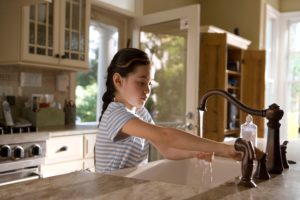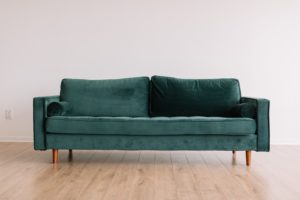 I’ve got to say it’s been confusing as hell trying to get crystal clear on where Australia, the US, Europe and other parts of the world sit with regulating Triclosan. In this follow-up blog, I have tried to clarify the hand sanitiser, hand soap question and I have also tried to step out where we will still encounter this harmful chemical.
I’ve got to say it’s been confusing as hell trying to get crystal clear on where Australia, the US, Europe and other parts of the world sit with regulating Triclosan. In this follow-up blog, I have tried to clarify the hand sanitiser, hand soap question and I have also tried to step out where we will still encounter this harmful chemical.
Before we go there, let me say I totally understand that at this time many people are freaking out about contracting Coronavirus. This makes sense. Being a holistic health practitioner I have a deep understanding of the immune system and its connection with the gut and our general health so it is easier for me to not feel as alarmed. That said I have friends and relatives who are immune-compromised, and I believe we all need to help minimize the spread of COVID-19 and their exposure to this virus.
What I’d love you to consider as you read this blog is if you typically lean towards heavy anti-bacterials cleaning products I urge you to read this blog and weigh up the cost/benefit ratio to your physical health and to the environment. This is obviously then a round-robin cycle that occurs through the devastation caused to plants and wildlife from these endocrine-disrupting chemicals. Is it really worth it? Particularly when authorities suggest Triclosan as an anti-bacterial and antifungal is no more effective in killing viruses then soap and water.
 Triclosan: Where Is It Found?
Triclosan: Where Is It Found?
Triclosan is a chemical that has been around since the 1960s and is used as an antibacterial and antifungal agent in personal care products and as a pesticide for decades and unfortunately is found in pretty much everything.
Depending on where you live – you could see triclosan in your soaps, antiseptic wipes, hand sanitizer, toothpaste, and mouth wash. Across the globe however you’re definitely going to find it in: your kid’s toys, cosmetic products, lip gloss, deodorants, shaving cream, first aid kits, clothes, office and school products, humidifiers, acne medications, rubbish bins, clothing, chopping boards, furniture, and credit cards to name just a few.
Concerns About Triclosan
The problem with this chemical is that it is extremely toxic. University of Maine biochemist Julie Gosse, PhD. has published studies on triclosan’s effects on mitochondria (organelles within the cell that act like a digestive system taking in nutrients and breaking them down, creating energy.)1
“We know that triclosan harms mitochondria, and we know that mitochondrial function is essential for reproduction amongst other things, and we know that triclosan affects reproduction.” she says.
Triclosan is also a suspected endocrine disruptor. In animal tests, triclosan interferes with thyroid hormone (serum total thyroxine), which is critical for normal growth and brain development, as well as male and female sex hormones, which are necessary for the normal growth and function of the reproductive system.8,9,10
Studies have found, “a reduction or absence of spermatozoa, abnormal spermatogenic cells, and partial depletion of one or more generations of germ cells in male testes” in hamsters exposed to a high dose of triclosan.11 Scientists fear that it may have the same effects on humans because humans have similar hormone systems as animals.12
Additionally, is concern that overuse of triclosan promotes antibiotic resistance among bacteria.13
New findings in animal studies of “a negative effect on both cardiac and skeletal muscle function as a result of a single triclosan treatment”. Another study found that “rats that were exposed to a high dose (3,000 ppm) of triclosan in utero showed lower neonatal survival and lower mean body weights compared to untreated controls.”13 In 2009, the Endocrine Society released a statement advising pregnant women and small children to avoid triclosan if possible, as developing organs are at a higher risk to be affected by the chemical. The Society commented, “even if some health effects are not fully proven scientifically, taking precautions is wise.”8
Humans are exposed to triclosan through the many consumer products and possibly by ingesting food grown in fields fertilized with contaminated sewage sludge.14,15
Plant Uptake of Triclosan
A study by researchers at the University of Toledo examined the uptake of three pharmaceuticals: carbamazepine, diphenhydramine (Benadryl), and fluoxetine(Prozac); and two personal care products: triclosan, and triclocarban, by soybean plants.16 The plants were grown in “treatments simulating biosolids application and wastewater irrigation.” The plants were then examined after growing for 60 and 110 days. The plants concentrated carbamazepine, triclosan, and triclocarban in their roots but the three chemicals were found translocated in the above-ground parts of the plants, including the beans. Concentrations were higher in the plants grown in simulated biosolids, or sewage sludge.
So Where Are We At With It?
According to the “Journal of Toxicology and Environment Health: Part B Critical Review”2, in September 2016, TCS was banned by the FDA in soap products (liquid, gel, foam, bar). The agency banned it from antibacterial soaps because, it said, companies failed to prove triclosan was safe. The FDA (basically the federal regulatory body in the US) did the same last year for over-the-counter antiseptic products, such as hand washes and surgical scrubs, in hospitals, doctors’ offices, and other health care settings.
The FDA’s ban is limited, in part, however, because of the way products are regulated. Soaps that make antibacterial claims are considered over-the-counter drugs and subject to FDA approval. But the agency has different regulatory power over products considered cosmetics, such as shaving gels and lotions, in which triclosan may be used as a preservative. These products don’t have to gain FDA approval before being sold. TCS still remains allowed in toothpaste, hand sanitizer, and mouthwash.3 Manufacturers of products containing triclosan must indicate its presence on the label.
With triclosan receiving attention many manufacturers have however elected to drop Triclosan from their products, it remains however still in many brands and products, and consumers do well to remember to check ingredients prior to purchasing.
Interestingly triclosan was not approved by the European Commission as an active substance for use in biocidal products for product-type 1 and TCS was banned from all human hygiene biocidal products starting January 2017. 4
 Whilst Triclosan is banned in Europe, in part in the US and Japan it is no surprise that triclosan is permitted for use in Australian products. Frustrating I know. I too, wish that there was more accountability and transparency with our regulatory agencies.
Whilst Triclosan is banned in Europe, in part in the US and Japan it is no surprise that triclosan is permitted for use in Australian products. Frustrating I know. I too, wish that there was more accountability and transparency with our regulatory agencies.
In an article for the ABC News 2016,5 Aldi, Woolworths and Johnson & Johnson that previously distributed soaps containing triclosan, have now eliminated the use of triclosan from their products. One would expect this move is likely to be a matter of maintaining the export of their products to the US, and vice versa and not entirely because they are concerned about consumer health.
Given the common use of antibacterial soaps, microbiologists agree that Australia should follow the US and ban triclosan. The United States FDA agreed that health concerns from scientists showed long-term exposure to these chemicals can promote antibiotic resistance, triclosan can disrupt hormones and it can potentially cause cancer. This precipitated the ban of triclosan in the US.
How else does this apply to Australia?
But what about the Australian-made antibacterial soaps that still contain triclosan? Yes, there are far fewer brands of soap and hand sanitizer that contain triclosan than there used to be, there are still some though. It is unlikely a similar ban could be imposed here because there is no Australian equivalent of the FDA with the jurisdiction to review and approve chemical products.6
In fact, the term ‘anti-bacterial’ agent is not supported with a TGA standard testing procedure, as disinfectants and sterilants are (TGO 54),7 against which the ACCC (Australian Competition Consumer Commission) could prosecute a manufacturer for misleading advertising. Therefore, always read the product labels and Safety Data Sheets carefully to see if contains triclosan.
 In Summary
In Summary
At this point, it’s probably best to think of this product as asbestos. It was used in almost every product out there and it took a long time for us to find out just how harmful it was.
When I look online for which brands contain triclosan it is unclear how up to date these product/brand lists are. To avoid naming brands (BIG brands) that may have dropped the chemical in the last couple of years I will have to leave the task with you – to check your purchases thoroughly.
Remember we aren’t just talking about soap and sanitizers here – you will need to check your toothpaste, make-up, medications, toys, clothing, furniture and all the items I outlined initially. Knowing of course that sadly certain areas of manufacturing are not required to list chemicals such as triclosan, so more than ever – it’s best to lean towards brands you know to be ethical.
In health,
Dr. Jen
References:
1 M. McMillen 07/09/2018. Banned From Soap, Is Triclosan Still a Concern? Medscape: WebMD Health News. [Online: Available] https://www.medscape.com/viewarticle/899074
2 Weatherly LM, Gosse JA. Triclosan exposure, transformation, and human health effects. J Toxicol Environ Health B Crit Rev. 2017;20(8):447–469. doi:10.1080/10937404.2017.1399306
3 Kux L 2016. “Federal Register” Vol. 81 No. 126 https://www.gpo.gov/fdsys/pkg/FR-2016-06-30/pdf/2016-15410.pdf. [Google Scholar]
4 Juncker J-C. 2016. Commission implementing decision not approving triclosan as an existing active substance for use in biocidal products for product-type 1. In 528/2012, edited by Union European. Brussels: Jean-Claude Juncker. [Google Scholar]
5 Antibacterial soap in spotlight as companies clamber to remove ineffective chemicals after US ban. Nicole Chettle. https://www.abc.net.au/news/2016-11-20/antibacterial-soaps-in-spotlight-as-companies-remove-chemicals/8040054
6 B. Gardener 2017. Does the FDA Antibacterial Soap ban apply in Australia? Inclean Magazine January 2017. https://www.freshgreenclean.com.au/will-the-antibacterial-soap-ban-affect-australia/
7 Department of Health 2020.Disinfectants, sterilants and sanitary products. Australian Government: Department of Health – Therapeutic Goods Administration.[Online: Available] https://www.tga.gov.au/disinfectants-sterilants-and-sanitary-products
8 Sandy Bauers, “[1],” Philadelphia Inquirer”, June 9, 2013.
9 Kevin M. Crofton, Katie B. Paul, Michael J. DeVito, Joan M. Hedge, “Short-term in vivo exposure to the water contaminant triclosan: Evidence for disruption of thyroxine,” Environmental Toxicology and Pharmacology 24 (2007) 194–197
10 Leah M. Zorrilla, Emily K. Gibson, Susan C. Jeffay, Kevin M. Crofton, Woodrow R. Setzer, Ralph L. Cooper, and Tammy E. Stoker, “The Effects of Triclosan on Puberty and Thyroid Hormones in Male Wistar Rats,” Toxicological Sciences, October 21, 2008
11 Kumar V, Chakraborty A, Kural MR, Roy P., “Alteration of testicular steroidogenesis and histopathology of reproductive system in male rats treated with triclosan,” Reproductive Toxicology, April 27, 2009
12 Natural Resources Defense Council, “Not Effective and Not Safe: The FDA Must Regulate Dangerous Antimicrobials in Everyday Products Facts,” April 2010
13 U.S. Food and Drug Administration, Safety and Effectiveness of Consumer Antiseptics; Topical Antimicrobial Drug Products for Over-the-Counter Human Use; Proposed Amendment of the Tentative Final Monograph; Reopening of Administrative Record, Federal Register, federal agency proposed rule, proposed December 17, 2013.
14 Centers for Disease Control, Fourth National Report on Human Exposure to Environmental Chemicals, Accessed August 5, 2010
15 Chenxi Wu, Alison L. Spongberg, Jason D. Witter, Min Fang, and Kevin P. Czajkowski, “Uptake of Pharmaceutical and Personal Care Products by Soybean Plants from Soils Applied with Biosolids and Irrigated with Contaminated Water”, Environmental Science and Technology, July 21, 2010, Accessed August 5, 2010
16 Chenxi Wu, Alison L. Spongberg, Jason D. Witter, Min Fang, and Kevin P. Czajkowski, “Uptake of Pharmaceutical and Personal Care Products by Soybean Plants from Soils Applied with Biosolids and Irrigated with Contaminated Water”, Environmental Science and Technology, July 21, 2010, Accessed August 5, 2010





